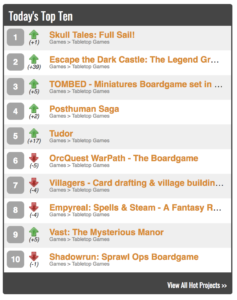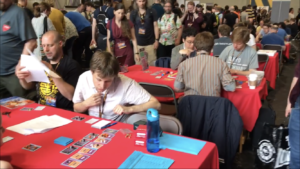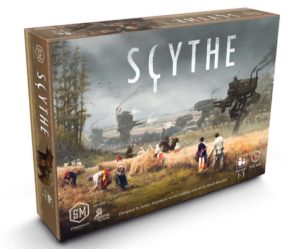Crowdfunding board games (or Tabletop games as they call them on the other side of the pond) has been in the last few years one of the most popular routes to bring them to market. And it’s no secret that I love board games.
As I have commented previously, I have run two rewards-based crowdfunding campaigns for a brewery and a community café as a creator and many others as a consultant. And although the principles to run any crowdfunding campaign are the same, each category has its own peculiarities. In preparation for that upcoming campaign, I did a bit of research digging deep into the Internet and visiting the UK Games Expo. This is what I learnt.
In case you prefer a video, here’s me going through this article:
Crowdfunding board games is popular and very competitive
The Kickstarter stats show how the category of games is (at the time of writing):
- The most funded (total money raised): $762.84 M
- The one with most live projects: 549
- The category with more projects raising more than $1m: 105
Also, the top 10 ‘hot projects’ list in Kicktraq is dominated by ‘Table Top’ games:
Very impressive indeed! There is clearly an audience eager to back the next hit in this area. And talking to the creators testing their games in the UK Games Expo, every single one of them mentioned Kickstarter as their way to launch!
But it’s not all good news. With so many projects active at any time, it’s a very competitive category, with a success rate of only 36.47%. That means that only one in three projects launched gets funded…
Some creators are moving away from it… some others regret not having paid enough attention
Jamey Stegmaier quitted Kickstarter after a string of 8 successful Tabletop games campaigns, culminating with Scythe, that raised $1.8m and is currently in 7th place at the overall Board Game Geek table. He lists his reasons in his amazing blog, and are mainly related to the amount of time it takes, the relationship with the distributors and the emotional toll – crowdfunding is not easy!
Ignacy Trzewiczek seems to be following an opposite path. He has published incredibly successful games like Stronghold and Robinson Crusoe with his company Portal without the help of crowdfunding and following the traditional route through distributors.
During the recent UK Games Show, I asked him about his approach. And surprisingly he told me he regretted ‘not having paid enough attention’. After all, 2017 was quite a mad year for crowdfunding:
- 7th Continent raised an astonishing $7m and went straight to the top 10 overall in the influential Board Game Geek table
- Gloomhaven: despite raising a ‘mere’ $4m, went straight to number 1 on that list. Amazing!
Successful teams plan their campaigns very carefully
There are two main types of successful campaigns:
- Those that reach their objectives towards the end of the campaign: I have written extensively about the 30-90-100 rule. This rule states that the campaigns that reach 30% of their objective in their first week have a 90% chance to reach 100% of their objective.
- Those that reach their objectives early in their campaign and significantly overfund. They usually have a well-structured set of stretch goals (more on them later). Again, there is a ‘rule’ for that: the power of 100 that might lead to a Big Bang.
In the early days, just the fact that you were crowdfunding was newsworthy. The platforms were not as crowded and it was easier to notice new, interesting projects. Not so easy now! You really need to bring your crowd to the platform. And either go for a steady campaign that will hit 30% on the first few days and the objective on the last few ones or (ideally) go for a ‘big bang’.
Here are some tips:
- Spend time building your community. Communicate with them regularly. Board Game Geek is a great resource for that and it will take time to build your credibility, so start ASAP!
- Plan your campaign objective (i.e. how much money you want to raise) to be as low as you can afford. Backers like to contribute to an already funded campaign.
- Design your rewards carefully:
- Use early birds cleverly to reach your funding milestones. Ideally, that should be 100%, but if your following is not big enough, then at least the 30%
- Structure your rewards in clear tiers. I will talk about pricing in another article, but here’s a starter for ten:
- There are different schools of thought when it comes to offering a low tier of rewards (stickers, posters, etc). On one side, this will bump the number of pledges, creating a bigger community. On the other, it will complicate your fulfilment for not much money (and not many pledgers). I would not do it, but certainly, there are plenty of successful campaigns that use them
- A core pledge that delivers the game
- A premium pledge: collector editions are quite popular. It is a great way to increase the average pledge, as upgrading from the core pledge should be a ‘no-brainer’ decision
- A super-premium pledge: including other items related to the game, such an art book. It won’t be as popular as the other pledges, but it has also the benefit of making the other prices seem more affordable.
- Use stretch goals to keep driving pledges after you’ve reached your 100%. Ideally, you want these goals to benefit all of the supporters. This will motivate them to keep sharing your project once they’ve pledged, as they want the upgrades on their game. [Update] I have written a whole blog post on stretch goals, their types, benefits and how to create them effectively.

Don’t get caught up in delivering your rewards!
The Internet is full of horror stories of campaigns unable to deliver their rewards on time, creators going AWOL, low-quality pieces… One famous case is ‘HeroQuest 25th Anniversary‘ (link in Spanish) that after two failed launches in 2014 due to copyright issues, went on to raise 680,000€. And as of today, the rewards are still to be delivered!
Again, the key here is planning carefully your manufacturing and rewards shipments. For the right project, backers will be happy to wait for their rewards.
So be conservative and don’t disappoint your backers. And it’s always better shipping before estimate dates than after. Especially if you have the next point in mind…
Once you have a successful campaign, you can tap into the same audience again and again
Successful game developers have a nearly ‘cult’ status. Ignacy from Portal joked about how he fills suitcases with cookies that he takes back to his native Poland. And, as we’ve seen with Jamey Stegmaier, he’s become an expert in crowdfunding board games. He’s done 8 successful campaigns!
Once you have a following, and it doesn’t need to be as big as one of the creators above, your fans are going to expect you to release at least a game a year. And that community will be the first to back your new game. Result! Just don’t disappoint them along the way…
Crowdfunding board games. Wrapping it up
Board games is one of the most popular categories of rewards-based crowdfunding campaigns. It has become the standard way of launching independent games, but the overall success rate is low. Building a community and planning your campaign carefully is key to increase the chances of success.
If you want to discuss all things about crowdfunding board games (or crowdfunding any other idea) don’t hesitate to Contact me






Could you help me with a board game that I invented so it may be launched and we may make some money? Please
Hi Juan Andres,
If you drop me a line via my contact me page with some details about the game, we can start a discussion of how I could help you.
Just to be clear, here are my fees. I never waiver them except for non-for-profit organisations close to my heart.
Looking forward to hearing from you.